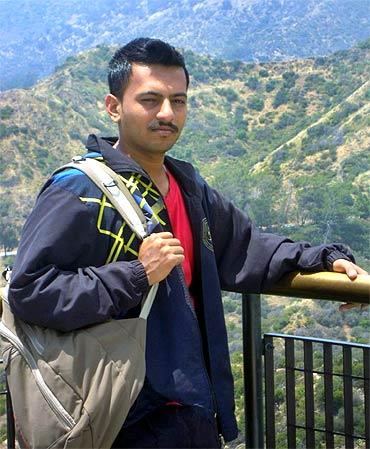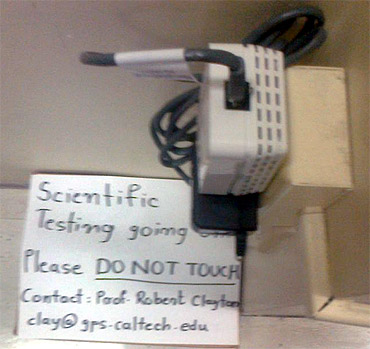 | « Back to article | Print this article |
A warning system for devastating quakes, courtesy IIT
Two students of IIT Gandhinagar are working on an early warning system that will help minimise the damage of massive earthquakes, reports Prasanna D Zore
The distance between the epicentre near the east coast of Honshu in Japan and the prefecture of Fukushima, where a nuclear plant was devastated by a tsunami triggered by an earthquake on March 11 this year, was 177 km.
The 8.9 magnitude earthquake must have taken less than 90 seconds to reach the nuclear plant.
Broadly speaking, seismic waves travel between two km/second and five km/second, say geology experts.
Imagine this: What if a central server had received the data picked from the sensors deployed along the faultline near Honshu in real time, analysed the velocity of the waves, the distance between the epicentre of this earthquake and the nuclear plant, and relayed a message about the duration in which the impending onslaught of waves would hit the nuclear plant.
It could have perhaps helped save numerous lives.
Now, a joint collaboration between IIT Gandhinagar and California Institute of Technology is trying to do just that. Two final year students from IIT Gandhinagar visited CIT for 11 weeks to work on a project that captures data of seismic waves through a sensor (like your smartphone accelerometer) in real time and transmits the same from a base station to a central server.
The two students, who are working on the prototype, even as they modify it for Indian scenarios, are hopeful that by February next year, they will be able to deploy these sensors along the active faultline in Bhuj, in Gujarat.
A warning system for devastating quakes, courtesy IIT
On January 26, 2001, Bhuj experienced an earthquake -- for two minutes -- of the magnitude of 7.7 on Richter scale that killed more than 20,000 people.
"We are testing the sensors developed for the Indian scenario," Girish Singhal, who is in charge of the project at IIT Gandhinagar, told rediff.com.
"We are planning to place these sensors (accelerometers) in the Bhuj area through which runs an active fault line," said fourth year electrical engineering student Prashant Borde.
At CIT, Prashant worked on standalone devices and on using power lines to relay data from each floor of a shaking building to a base station on the top of the building.
The base station in turn had Internet connectivity through which the collected data was transferred to a central server where it was analysed based on various parameters.
"Though the data is captured in real time without any inherent lag, there could be a delay of some milliseconds in the transfer of this data from the device on each floor to the base station in the building," said Prashant.
"Furthermore, there could be a delay of a few more milliseconds in the transfer of data from the base station to the central server because of the Internet infrastructure," Prashant added
"The project that we worked on was about minimising the delay in the transfer of data from accelerometers on each floor of the building to the base station," he said.
These accelerometers, Prashant explained, helps in catching accelerations along the three axes: X, Y and Z.
"If these sensors detect accelerations above a threshold it will send a message to a central server that it has detected a seismic wave and will send the magnitude of this wave to the server," he added.
The chief aim of this project is to help build a system that will help first line responders to take urgent action to prevent catastrophes along the path that seismic waves travel in, especially in cities with high population density.
For instance, if this system had been functional before the Bhuj earthquake of 2001 then Ahmedabad, which is nearly 300 km from the epicentre, could have had a couple of minutes of lead time to take precautionary measures.
A warning system for devastating quakes, courtesy IIT
It is a slightly early detection of earthquake. It can help prevent an outbreak of fire by turning off big machineries and power plants and it can greatly help in disaster management," Professor Singhal said.
According to Prashant, seismic waves would have taken approximately two to three minutes to cover a distance of 300 km to Ahmedabad.
"This could help in warning people in the line of the earthquake to take precautionary measure," Prashant said.
However, the prototype is under trial and needs some modifications to suit the Indian scenario before its full-scale deployment in Bhuj.
"Sensors developed by CIT use the Internet for transmission of data from the base station to the central server," said Professor Singhal.
In India, Internet penetration is not very high and so the team at IIT Gandhinagar is trying to make use of GSM technology to transfer the data to the receiving central server.
"Because GSM is more ubiquitous in India compared to Internet penetration, we are exploring using GSM technology," Prof Singhal said.
In a way using GSM, because of its cheap availability, will also make sensors in India more affordable.
IIT Gandhinagar is leading the way by making these accelerometers more affordable and suitable to India.
While these sensors (accelerometers), the size of a mouse, cost anywhere from $130 (Rs 6,500 approximately, assuming $1 = Rs 50) to $150 (Rs 7,500 approximately) in the US, in India they could be made for as little as $40 (Rs 1,000 approximately) by using GSM technology and manufacturing the sensors in India instead of importing them, believes Prashant.


